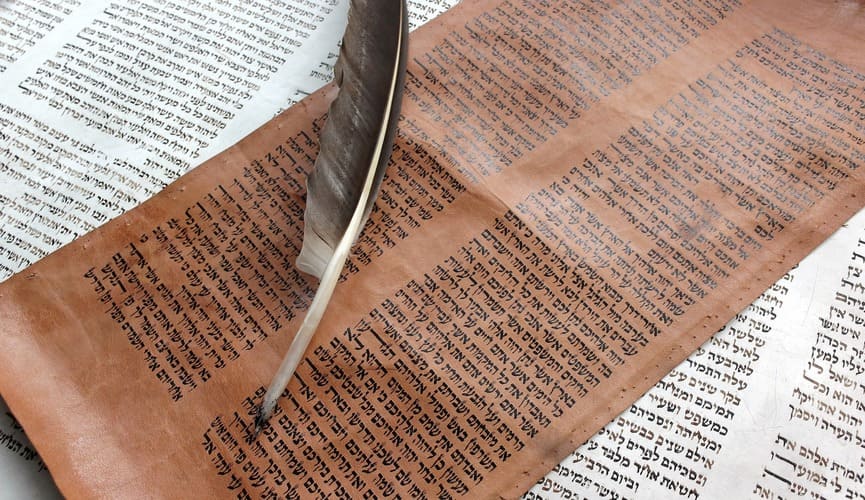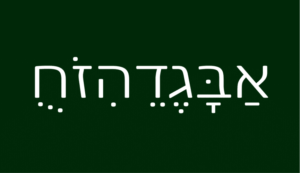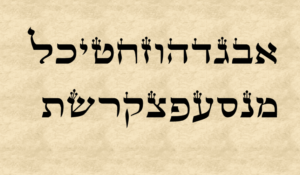A question I often get asked is the difference between Biblical Hebrew and Modern Hebrew.
First, we must know that whether biblical or modern, we are talking about the same language. They are not different or separate languages. But then what is the difference between them?
In order to simplify, let’s discuss about the two basic points of differentiation of this variants: the time and the application of it.
The time
Biblical Hebrew was the language used in the ancient world, about three thousand years ago. It was spoken in the land of Israel in biblical times.
Modern Hebrew is the language used in Israel nowadays.
As the world changes, also the languages evolve. All languages are susceptible to transformations across time. Do you think that a thousand years ago people spoke English the same way as we speak today? Certainly they have some differences, although they are still the same language.
What are the changes that may occur in a language?
The first change that may occur is the emergence of new words. Any modern language has far more words than its predecessor had in the past.
Today we need to talk about computers, phones, airplanes, cars, electricity, and a million more things that didn’t exist in the past.
Therefore Modern Hebrew speaks of things that did not exist in biblical times. There is a need to express more complex ideas.


The second change that may happen is the simplification of some linguistic structures, such as spelling, pronunciation rules and grammatical syntax. These structures can be replaced by other simpler models present in other known languages.
In the English language there were several changes in spelling, for an example the word “queen” used to be written as “cwen” in old English.
In the other hand, Hebrew did not undergo significant changes in spelling (although there were changes in the pictographic Hebrew script, as we saw in the article regarding the alphabet).
But there are some complicated structures in verbal language that were replaced by more “practical” ways of grammar or in some way a more colloquial speech. For example, the declension of words to form the possessive is replaced by the use of a preposition that indicates the possessive form. This avoids the need of “declining” the words all the time. Also, some forms of more complex verb conjugations are not commonly used.
Example:
הסוסים
“Hassussim”
Meaning “the horses“.
In Modern Hebrew, if I mean
“the horses of David“, I say:
הסוסים של דויד
“Hassussim shel David“,
the “shel” being the equivalent of “of” in English.
Now in classical Hebrew, to say
“the horses of David” would be like this:
סוסי דויד
“Sussei David“.
Although it got shorter, I needed to change the word “Hassussim” in to “Sussei“.
The birth of Modern Hebrew
A different interesting fact occurred with Hebrew evolution in comparison to English or other languages, its changes did not come through a natural process of transformation by its speakers over the last centuries.
The Hebrew language went many years without being spoken as a living language; it had already become a “dead” language. It was just a language for Bible study, literature and liturgy.
In the passage between the 19th and 20th century the language was resurrected, rebuilt from Biblical Hebrew, mainly by the work of the linguist named Eliezer ben Yehuda. After his work, new words of the modern world were created and added to the resurrect idiom, and Hebrew became the official language of Israel.

The application
We have already said that, the first difference between Biblical Hebrew and Modern Hebrew is the time. They are both the same language but at different moments of time, so you can see that there are some differences between them.
The second thing we are going to talk about is the application. For what reasons should I learn Modern Hebrew or biblical Hebrew? What are they used for?
Modern Hebrew is the language used today for any purpose, whether in colloquial conversation, watching television, using the internet, or in a formal speech; whether in the writing of a newspaper, a scientific article, a gossip magazine, or a book on any subject, including modern literary works.
Whoever studies Modern Hebrew aims to communicate in the language in all ways, that is, to talk, speak, listen, write and read any modern texts.
Now Biblical Hebrew, in fact, is not simply the Hebrew that was spoken 3,000 years ago, but it is a literary language.
Biblical Hebrew is the language of 3,000 years ago that was used in sacred literature.
It was not the colloquial language used in people’s daily lives. It was the cultured language of the time. The Biblical text, although simple, is a text of a literary character, which has art and erudition, whether in poetry or prose.
No, people did not speak with erudition at that time. They had their colloquial language, their regionalisms, their “slang”, and different ways of speaking in different social groups and contexts.
But to write sacred texts, a literary language was used.
Therefore, studying Biblical Hebrew is not simply studying ancient Hebrew, but studying a language used in a specific literature, which is the Biblical text.
Studying Biblical Hebrew is studying a fully applied and specific literary language. The purpose of studying Biblical Hebrew is to read the Bible in Hebrew.
Summarizing…
For practical terms: If your goal is to converse in Hebrew, to live in Israel, and to read current texts, you need to study Modern Hebrew. You need to learn the modern vocabulary, the everyday language, and focus mainly on conversation.
But if your goal is to read the Bible in its original language, you need to learn Biblical Hebrew, which is the literary language of the Bible, and then your focus will not be on conversation, but on reading texts.
But the good news is that to start your studies for both for Biblical Hebrew and for Modern, the path is one: you need to learn how to read, and the writing is the same.
By learning to read in Hebrew, you will be able to study both the Biblical and the modern, or both, with the difference that in Modern Hebrew you will soon have to read without vowels, while in the Biblical you will not necessarily need to worry about it. But believe me, reading without vowels is easier than you think, as you start to know the language, you will naturally identify the words.

The difference between Hebrew and Aramaic
In this article we are going to talk about another frequently asked question: What is the difference between Hebrew and Aramaic languages? As a simple starting

The Hebrew vowels
Hebrew vowels are represented by signs that are not part of the alphabet. In fact, vowels are not originally written in Hebrew language (they are

The difference between Biblical Hebrew and Modern Hebrew
A question I often get asked is the difference between Biblical Hebrew and Modern Hebrew. First, we must know that whether biblical or modern, we

The Hebrew Alphabet
The Hebrew language is written with an alphabet quite different from the one we use in English. The “alef-beit”, as the Hebrew alphabet is known,

